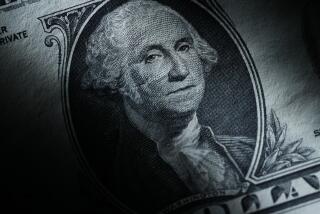Strong S&Ls; Also Pay High Interest
- Share via
Many savers have shied away from putting their money in highest-yielding savings accounts and certificates of deposit out of concern that the institutions offering high rates were often out-of-state outfits considered financially shaky.
But these days, top-paying institutions are not necessarily on the brink of insolvency. You can now get the highest rates from among the strongest banks and savings and loans in the country.
In recent months, troubled institutions--particularly in California and Texas, where industry problems are the worst--have been pressured by regulators to become less aggressive in rate setting. Or they have been merged into stronger institutions.
The weak outfits had offered high rates to attract deposits, but that cut industry profits and worsened conditions of many thrifts, which brought about President Bush’s $90-billion thrift bailout plan announced this month. While many troubled thrifts are still offering high rates, they don’t dominate the lists like they used to.
Meanwhile, in some parts of the nation, particularly the Northeast, strong economic growth has boosted demand for loans. That, in turn, has spurred healthy institutions to seek deposits aggressively by offering higher rates.
“In previous years, the Texas and California institutions used to dominate the market,” says Norberto Mehl, chairman of Banxquote Money Markets, a New York bank rate information service. “Currently, there is participation by various states. Now you see strong institutions, particularly from New England S&Ls.;”
“Most people are in shock” when they hear that stronger institutions are paying among the highest yields, says Robert K. Heady, publisher of 100 Highest Yields, a North Palm Beach, Fla., newsletter. “There is a misconception that every thrift on the sick list is paying the highest yields in America.”
A look at the list of institutions with top-paying CDs shows what a difference a year makes.
A year ago, troubled thrifts in Texas composed three-fourths of the 100 highest-paying institutions, Heady says. Now, he says, they represent only 10% of the list.
Meanwhile, Northeast S&Ls; compose two-thirds of the rankings, up from only one-fourth a year ago. Well over half of those are considered financially strong, he says.
Examples of strong institutions paying high rates are numerous. Strong institutions listed as among the highest-paying this week by Banxquote Money Markets include New Haven Savings of New Haven, Conn., offering a 8.5% rate on a two-month CD; Safra National Bank of New York, offering 8.25% on a one-month CD and 9.21% on a two-year CD; First Deposit of Tilton, N.H., offering 8.67% on a money market deposit account, and Acacia Federal of Annandale, Va., offering 9.25% on a five-year CD.
This is good news for savers because it makes banking with out-of-state institutions a less worrisome experience. Even though you can’t lose your money if your deposits are under the $100,000 federal deposit insurance limit per institution, there is added security in knowing that you won’t have to hassle with delays of as long as a week in getting your money back if your institution fails and you cannot be there in person to claim your funds.
Another positive implication of this trend: The Administration’s planned takeover of 224 troubled S&Ls; under its bailout plan won’t necessarily cut CD rates sharply for savers, Heady argues. The government is likely to force ailing institutions that it takes over to cease offering above-market rates, but that won’t affect stronger institutions.
How should you go about depositing funds at an out-of-state bank? Heady and other experts provide the following tips:
- Find out what banks or S&Ls; are paying the highest yields. You can do this by looking at listings in newspapers or business publications, or by subscribing to one of several services that lists highest-yielding accounts. One of the best known is 100 Highest Yields (Box 088888, North Palm Beach, Fla. 33408-9990; telephone 800-327-7717).
- Write or call the institution to ask questions and request an application or account form. Ask for the person handling consumer deposit accounts and take down his or her name. Ask about the institution’s penalties for early withdrawal, and if and when it will notify you that your CD is coming due.
- If the institution doesn’t pro vide an application or account form, weigh carefully whether you still want to do business with it. If you decide to go ahead, write a detailed letter to the officer who will open your account. Specify your name, address, phone number and social security number, what type of account you want opened, the maturity date, and the rate and yield you were quoted.
Also request in that letter that the institution open an account only if it can still give you the rate you were quoted. If the rate has changed, ask the institution to call you immediately.
Also ask the institution to send you a deposit receipt for the amount you are sending, plus any account papers and other relevant documents. Make copies of all documents you send and call a few days later to make sure your check was received and everything is in order.
- When sending a check by mail, make it payable to the institution, not an individual. Endorse it “for deposit only.”
Or consider having the funds wired from your current institution. That would get your money to the new institution quicker.
Bill Sing welcomes readers’ comments and suggestions for columns but regrets that he cannot respond individually to letters. Write to Bill Sing, Personal Finance, Los Angeles Times, Times Mirror Square, Los Angeles, Calif. 90053.
More to Read
Inside the business of entertainment
The Wide Shot brings you news, analysis and insights on everything from streaming wars to production — and what it all means for the future.
You may occasionally receive promotional content from the Los Angeles Times.









